Tackling child poverty delivery plan 2022-2026 - annex 6: what works - evidence review
This annex to the second tackling child poverty delivery plan 2022 to 2026 summarises the latest evidence on what works in tackling child poverty.
2. Overview into priority families
This chapter provides an overview of the evidence on what works to help each of the priority family types out of poverty. The six priority family types are all identified as being at a higher risk of poverty. These are:
- lone parents
- young mothers (under 25 years old)
- minority ethnic families
- large families (with three or more children)
- families with a baby (under one)
- families with a disabled adult or child.
This chapter provides a summary of what the evidence suggests works, or could work where empirical evidence is limited, for each of these family types. However, it is important to remember that there is considerable overlap across the different groups, with families in poverty likely to fall into two or more of these categories.[39] It is also essential to consider families who are experiencing particularly complex and layered forms of disadvantage and adversity, and who will often face the hardest route out of poverty. These families will cut across all of the priority family types, and we turn to these first.
Families experiencing multiple disadvantage
Some families experience multiple disadvantages or adversities. These can include homelessness, offending, child protection interventions, child removals, stigma, trauma, marginalisation, substance dependency, domestic violence and mental health problems. These families are often among those deepest in poverty and who face particularly challenging journeys to get out. For families experiencing multiple disadvantages or adversities, these issues are often deeply interconnected, overlapping and intersecting with each other and with poverty in complex ways. Although there is not a simple causal relationship between these issues and poverty, multiple disadvantages and adversities can make it harder to get out of poverty and poverty can also make it harder to overcome adversities.[40] [41] [42] So, although this is a relatively small group, the implications are huge for the families involved.[42]Most of these families will also fall into at least one of our priority family groups. This matters to child poverty because the barriers faced and the support needed by those experiencing multiple disadvantage will be significant and highly specific.
Responses to poverty which focus broadly on the drivers may not be enough by themselves for families who experience multiple adversities and poverty. People may need more support. Services and approaches for people with multiple disadvantages need to:
- be flexible and able to cope with complexity rather than single issues
- be available when and where families need them
- prioritise building a trusting relationship with a lead worker, and
- not give up on people too quickly.[42]
Sources of income
Before we look at each of the priority family types in more depth, it is helpful to consider how they differ at a high level in terms of their economic status – particularly, how likely it is that their highest income householder is in paid work. As with many other characteristics, the priority groups vary significantly in terms of the proportion of their income that comes on average from employment and social security (see Chapter 4) and how likely the highest income householder is to be in paid work, sick or disabled, unemployed, economically inactive, or looking after their family or home.[43]
Children in poverty are most likely to live in a household where the highest income householder is in paid work (see Figure 1 for further detail). The proportion of children for which this is true is higher for some priority groups than others, such as minority ethnic families (76% in paid work), large families (67%) and families with a baby (65%), than for others. Children in lone parent families (40%) or families with a young mother (42%) are least likely to have a highest income householder in paid work, and most likely to have a highest income householder who is looking after their family or home. Children in poverty with a disabled family member or a lone parent are most likely to have a highest income householder who is economically inactive due to sickness or disability.
The following sections of this chapter look at each priority family type one by one. Empirical evidence of what works for these family types is not robust throughout all drivers or for all groups. When there are gaps, the report considers other evidence on what should work, rather than on what is known and proven to actually work.
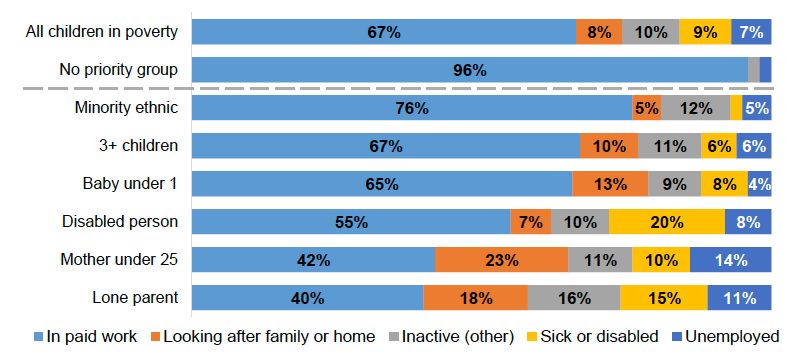
Lone parents
Lone parents are much more likely than average to not be in paid employment, spend more of their income on basic living costs (such as housing, food and fuel) and to be impacted by cuts or freezes to the benefit system.[44] [45] The vast majority of lone parent households are led by women. As such, successful interventions are generally those geared positively towards gender equality.
Overall, evidence points towards a review of the system to refocus on the wide range of individual complex needs.[46] It would mean placing the person at the centre and allowing them the autonomy to design the support they need. There is a growing body of evidence that suggests that this can have a positive impact on both medium and long-term outcomes.[47] [48] This is true for all people experiencing poverty, but particularly relevant for lone parents as it will help them to navigate structural barriers in their journey out of poverty. The figure below summarises key findings around what the evidence suggests should work to support lone parents in relation to each of the drivers of poverty.
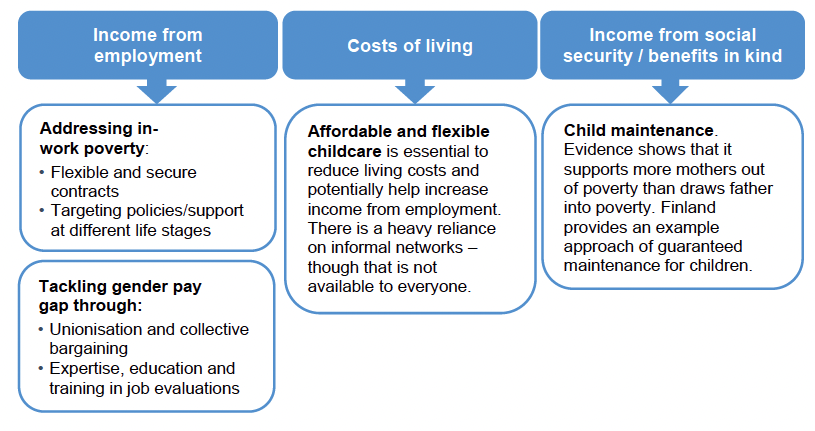
What works? Driving the gender equality agenda.
Evidence suggests that interventions that support gender equality, both in the workplace and in society in general, are likely to benefit lone parents, who are more likely to be mothers. This includes: tackling the gender pay gap,[49] allowing flexible working hours that support family life,[50] specific schemes to support career progression[51] and also minimising stigma of the working mother.[52]
However, the first barrier for lone parents is their ability to juggle paid work with sole responsibility for the family. While some have access to informal childcare from family or close friends, that support is not available for everyone. For many, childcare is therefore a major barrier, with a lack of flexible and affordable childcare options that support not only office working hours, but also irregular working patterns like shift work. More detail is provided in Chapter 5 – Childcare.
What works? Addressing different needs at different life stages.
Children grow and the support they require changes. There are certain transition points in a child's life that will particularly impact on family logistics. One is when a child can go to nursery, another when they start primary school, and a third when they start secondary education. Childcare needs and career aspirations of lone parents will change over that time and reaching families at those turning points would be key in supporting them.[53]
What works? Child maintenance.
Evidence shows that child maintenance supports more mothers out of poverty than it draws fathers in. An example of an alternative approach can be found in Finland, where they have a guaranteed child maintenance for children.[54] [55]
Young mothers (under 25 years old)
The review did not find any evidence of tested policies or interventions of what works to help young mothers out of poverty. Therefore, this section focuses solely on evidence that is likely to positively impact on specific issues faced by young mothers. However, policies developed to support lone parents are likely to reach young mothers too, as there is a considerable proportion of young mothers who are also lone parents.
The visual below portrays the key areas of work likely to have a positive impact on the life of young mothers, but they are based on evidence around what should work, rather than on empirical reviews of what does work in practice.
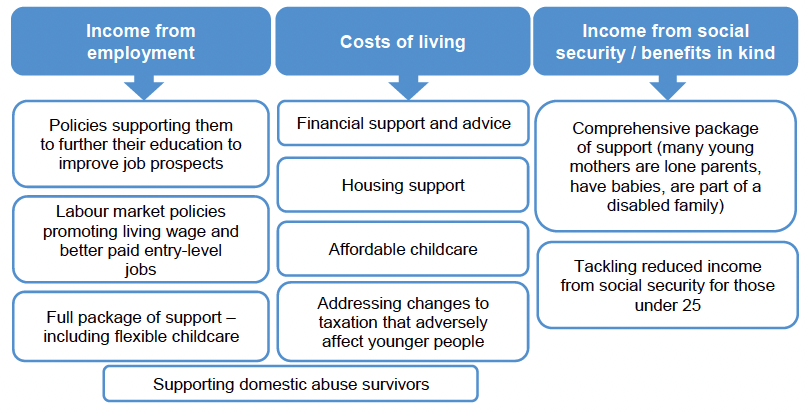
What works? Making paid work an option.
Targeted policies that support young mothers to further their education are likely to improve job prospects.[56] However, this should be supported by labour market policies that pursue well paid entry-level positions (e.g. at the living wage). In addition, there needs to be a childcare infrastructure that would allow young mothers to do paid work considering the age and changing needs of their children. [50], [53]
What works? A safe home.
Pregnant young women and young mothers (under 21) make up about 1 in 25 of all applications for homeless assessments in Scotland. Some of them will likely be domestic abuse survivors with very limited support networks. The targeting of policies that support safe housing for young mothers in particular will be beneficial.[57]
What works? Enhanced support through social security.
Young mothers are more likely than other priority groups to be in poverty despite being in paid work. They are also more likely to be reliant on social security benefits. However, the generosity of benefits for the under 25s is lower than for older age groups. In addition, the tax system has been found to adversely affect young people and women.[58]
Minority ethnic families
While there is a wide range of evidence on the issues and barriers faced by minority ethnic families, there is very limited evidence on what works to support them in their journey out of poverty. This overview of what works is based on what the evidence states should work considering the barriers known, rather than on empirical reviews of what does work in practice.
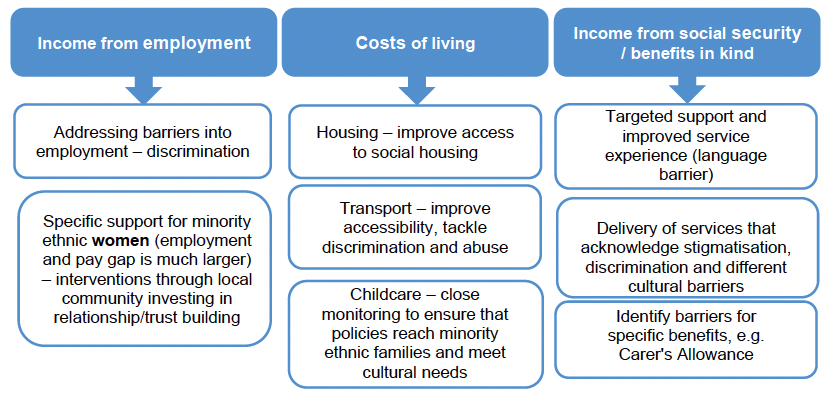
Generally, minority ethnic families are much more reliant on income from employment than from social security. Therefore, policies that help tackle in-work poverty will benefit people from minority ethnic backgrounds. However, beyond generic approaches that can work for all, there are specific areas to consider for this family type.
What works? Addressing racial discrimination and harassment.
All policies or interventions need to actively address the discrimination, stigma, structural and cultural racism that many minority ethnic families still face every day. Although minority ethnic people are more likely to be in poverty than white people, anti-poverty policies and strategies have so far had little focus on race.[59] Embedding of the Race Equality Framework into all policy actions tackling poverty and targeting policies specifically to support minority ethnic families is required.
What works? Targeting policies to address specific barriers.
While educational outcomes are generally high and positive for many minority ethnic families, this doesn't translate into good employment opportunities.[60] People from minority ethnicities tend to be overrepresented in lower paid sectors and there seems to be a barrier in career progression.
Specific targeted policies that support people from minority ethnicities into employment in the first place, and then support career opportunities, are essential. These policies will need to understand the deep-rooted racial discrimination many families face.[61] Policies to help increase employment would need to address transport barriers and ensure that childcare policies also reach minority ethnic families when needed. A Joseph Rowntree Foundation report found that lack of knowledge and information about childcare or support for carers is an important factor in low take-up among some minority ethnic groups, and there is also a lack of inclusive services (both childcare and other care services) that take into account cultural and religious differences.[62] A more recent report by Close the Gap echoed and added to these findings, and suggested that the lack of cultural sensitivities in formal childcare may be putting some families off from using this type of childcare.[63] For migrant minority ethnic women, the lack of alternative informal networks to help with childcare limited their ability to enter the workforce or increase their working hours.
What works? Maximising reach and uptake of social security benefits.
There is a need for policies that actively target and encourage take-up for minority ethnic families. This will require targeted support and an improved service experience – for example, by addressing language barriers and better understanding cultural norms. Studies have demonstrated that minority ethnic groups can face racial discrimination and prejudice when interacting with public services and organisations, including when accessing benefits or seeking support.[64]
What works? Addressing the gender pay gap.
In general terms we know that there is a significant gender pay gap, but this is exacerbated for minority ethnic women. [63] [65] Minority ethnic women in Scotland continue to face structural and practical barriers to accessing and navigating the labour market, including racist and sexist attitudes and discrimination.[66] A Department for Work and Pensions intervention to support minority ethnic women into paid work found that successful interventions are those that maximise local connections and invest in relationship building and trust.[67] However, this assumes that local networks are well funded and established – and that those local contacts understand issues and can help minority ethnic families in their journey out of poverty. Relying on third sector and local organisations, without ensuring the infrastructure is in place, is unlikely to work.
What works? Targeted support to affordable housing.
Generally, minority ethnic families tend to rely on the private rented sector more than social housing. This appears to be due to a number of issues, but mainly focuses around the size of available housing (with minority ethnic families tending to be larger) and also, importantly, safety from racial harassment.[68] Accessing secure housing is harder for women as well as for those fleeing domestic abuse.[69] There is no evidence on what works around supporting minority ethnic individuals and families into affordable housing, perhaps as a reflection of a lack of policies specifically tailored to support them.
Families with three or more children
Larger families, with three or more children, are more likely to be in poverty than smaller families. Larger families face higher costs of living, including for childcare, cost of the school day and holidays, housing, fuel, food and transport. Parents in larger families are also likely to be out of the labour market for longer periods of time, which can limit their future employment opportunities.[70]
The visual below portrays the key areas of work likely to have a positive impact on child poverty among families with three or more children. These are based on evidence around what should work, rather than on empirical evidence of what does work in practice. While there is some evidence on the barriers larger families face, few policies have been designed specifically for this group and evaluations of overarching child poverty policies have not tended to draw out learning on what works for large families specifically.
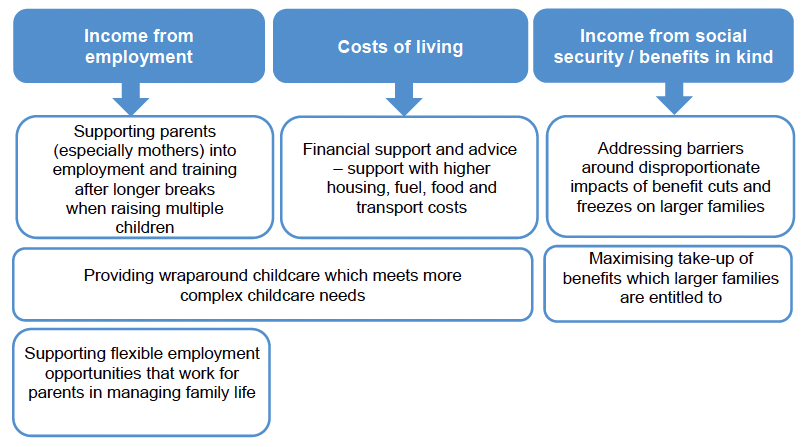
What works? Developing policies and interventions with an awareness of barriers that large families face.
There are few interventions specifically aimed at reducing child poverty for large families, either in Scotland or internationally. A review by NHS Health Scotland found no evidence or case studies of local interventions specifically aimed at reducing poverty within larger families.[71] What can be done is ensuring that existing or proposed national and local actions are designed in a way which works well and can contribute to reducing child poverty specifically for larger families. Policies and practices should not penalise larger families and should be 'larger family proofed' to ensure people are not inadvertently penalised for their family size. One suggested way of ensuring this is done systematically is by adapting existing toolkits (e.g. the participatory one parent proofing toolkit) for larger families.[72]
What works? Addressing barriers around disproportionate impacts of benefit cuts and freezes.
Since 2013, changes to the UK benefits system (the benefit cap and the two child limit) have reduced both the real terms value of social security benefits paid to low income larger families and restricted the benefits system, with the changes predicted to push many more larger families into poverty. [73] [74] It is important to recognise and look for ways to support families who will struggle as a result of these changes, as families impacted by them are increasingly struggling to meet basic needs and the cost of living.[75]
What works? Maximising take-up of available benefits.
Aside from reforms to these benefits, it is important to raise awareness of benefits that larger families are entitled to receive for all children. For example, the two child limit does not apply to Best Start Grants or the Scottish Child Payment.[70]We also know that there are barriers with awareness and understanding of the benefit system for minority ethnic families so improving take-up in this group will be useful for helping larger families.[75]
What works? Supporting parents into training and employment after longer breaks.
Having a larger number of children can impact on parents' ability to take on paid work, especially mothers who are often the full-time carer when children are young and will have to wait longer until all children are eligible for funded early learning and childcare.[76] Childcare policies can be effective in giving parents the freedom of choice to return to paid work, when it is provided with wraparound provision and consistently over the childhood period from early ages.[77] There is limited evidence about specific employment interventions that can work to support parents with three or more children to secure and maintain employment. We do know, however, that flexible employment which works around parents' care needs and creates conditions to give them the freedom of choice to return to paid work is important to fit individual circumstances.[78]
What works? Targeting support to specific socio-economic issues larger families may face.
In terms of socio-economic circumstances, families with three children are more similar to those with one or two children in terms of health, education and skills of adults in the household. However, families with four or more children are more likely to have adults with few or no qualifications and to have poorer health among adults in the household. Research suggests that interventions to support larger families should be designed with an awareness of these particular issues and that the largest families (i.e. with four or more children) may require additional and distinct support with health, education and skills if their risk of poverty is to be reduced.[70]
Families with a child under 12 months
This section focuses on evidence about what could help families with a child under 12 months of age. Due to the overlap between priority groups, policies that help or target lone parents, mothers under 25, or families where someone is disabled are likely to also help many families with babies. The majority (65%) of families with a baby in poverty have at least one adult in paid work.[79] Evidence suggests that tackling poverty for this group is about balancing welcoming new parents into paid work byenabling flexible work and childcare, while also supporting those who want to stay at home by improving parental leave.
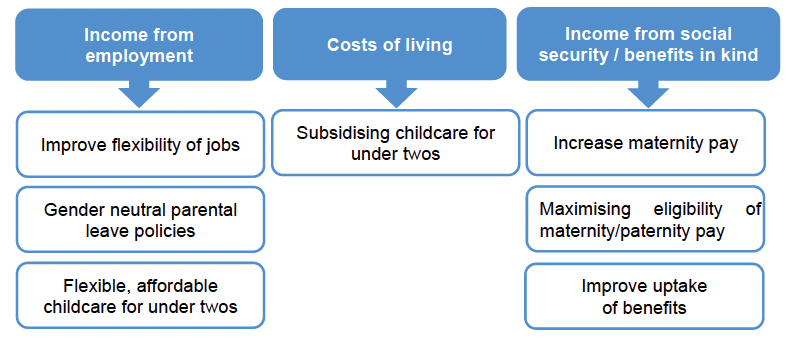
What works? Improving maternity pay.
Families often see a significant reduction in income while relying on parental pay or benefits. Even at the highest rate (£151.97 per week), maternity allowance is worth less than half the living wage rate.[80] [81] [82] Although Statutory Maternity Leave is available for 52 weeks, statutory Maternity Pay and Maternity Allowance is only payable for 39 weeks, leaving a three month gap in which, if mothers wish to be at home with their baby, they do not receive an income. Insecure and unpredictable work, and loss of working hours, sometimes due to discrimination during pregnancy, affect women's entitlement to Statutory Maternity Pay or Maternity Allowance. For some women this was exacerbated during the COVID-19 pandemic when pregnant women were initially advised to isolate.[83] [84] Addressing these gaps in maternity pay is likely to prevent some families with a baby from falling into poverty.
What works? Gender-neutral parental leave policies.
Much of the gender pay gap is related to women's disproportionate responsibilities in the home, which is reinforced by inequitable parental leave policy, making it harder for women to return to and progress in paid work. The UK's parental leave provision implies that mothers should be babies' main carers: mothers are entitled to 52 weeks of maternity leave, compared to two weeks paternity leave for fathers. Althoughshared parental leave is available in the UK, it offers the option for mothers to transfer some of their leave to fathers, rather than offering leave to both fathers and mothers on a 'use it or lose it' basis. Recent take-up figures suggest that less than 4% of fathers have taken this up.[85] In countries which offer equal rights to mothers and fathers to take well paid parental leave on a non-transferable 'use it or lose it' basis, a high proportion of fathers use this leave (for example 86% of fathers in Iceland, averaging 3 months each, used it in 2017).[86] [87]
What works? Providing flexible jobs and flexible, affordable childcare.
Mothers who stop paid work after having a child and do not return by the time the child is five are more likely to be younger, to be single mothers, and to be living in the most deprived areas. The most common reason for mothers who are seeking paid work to not be able to find it is a lack of suitable jobs, particularly part-time jobs. This suggests that providing more flexible jobs would help parents who want to, to return to work.[88] Improving childcare affordability and making it available directly after parental leave would also support this return to work. [89] [90] [91] Currently the lack of funded hours for parents with children under the age of two, combined with a lack of gender-equal parental leave policies, can make it difficult for mothers, and particularly lone parents, to return to work.[92][91][82][86]
What works? Maximising take-up of relevant benefits.
As well as Scottish Child Payment and Child Benefit,Best Start Grant (Pregnancy and Baby Payment) and Best Start Foods are means-tested benefits[i] available for families with a child under one. The estimated take-up rate for the Best Start Grant Pregnancy and Baby Payment is 79%, and for Best Start Foods is 77%.[93] Evaluation suggests that these benefits have had a positive impact on households' finances and enabled some people to meet key expenses.[94] Using existing points of contact, such as registration of children's births and through midwives and health visitors, to provide social security advice, information and referrals to new parents can support those experiencing, or at risk of, child poverty.[95] [96] [97] Estimated take-up of Scotland's universal Baby Box scheme is over 90%, with 91% of recipients saying it had saved them money. Parents on low incomes were more likely than others to say the box had financial benefits.[98]
Families with a disabled adult or child
Children in families with at least one disabled adult or child account for over two-fifths (42%) of all children in relative poverty, and just under three-fifths (58%) of those in combined low income and material deprivation.[99] Thirty percent of children in households with a disabled adult or child were also in a lone parent household, and 30% were in a household with 3 or more children (2011-18).[100]
There is no single obvious lever for tackling child poverty among disabled families, with each individual family's circumstances being highly unique and requiring a tailored package to meet their needs. However, stability combined with flexibility in work, care, support and income packages appears to be key.
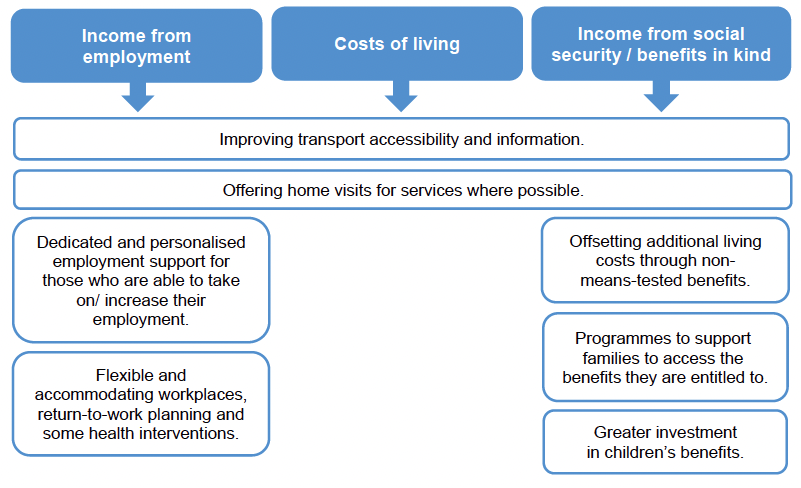
What works? Dedicated and personalised employment support.
Compared to non-disabled parents, disabled parents are far less likely to be employed, and those who are employed tend to work less hours.[101] While health needs or caring responsibilities mean that employment is not a realistic option for all parents in families where they and/or someone else is disabled, many who are not currently in employment would like to be. Support not only to find, but also to remain and progress in employment, is therefore key. Supported employment programmes, which work directly with both disabled (potential) employees and employers to find suitable jobs and support people into them and to remain in them, have been found effective in the past.[102] Programmes can be helpfully targeted to people with specific impairments.[103] Continuity of support and staff with good interpersonal skills are valued by service users.[104] There is also some evidence that return-to-work planning and some health interventions could help facilitate disabled people's employment – as well as flexible and accommodating workplaces, which may be particularly important for parents.[105]
What works? Improving transport accessibility.
Disabled people face a number of challenges with the transport system.[106] Many of these are likely to be even more difficult when travelling with young children, and can also be exacerbated in rural areas.[107] Targeted travel card entitlements, such as for carers or disabled people, can be helpful in reducing the cost of transport and subsequently reducing household outgoings and enabling participation in different areas of life.[108]
Electronic information points providing real time information on services also helps with planning. Meanwhile pick-up services have been suggested as a potentially useful service by low-income families and there are initial positive findings for some demand-responsive bus services, in particular in areas or at times where buses services are limited. Transport can be a barrier to accessing social security services among others, and many disabled recipients or those with health conditions would prefer home visits.[109] Recipients also say they would find it helpful to receive transport information with their appointment confirmations.
What works? Offsetting additional living costs through social security.
It is generally recognised that disabled people face higher living costs than non-disabled people.[110] Non-means-tested benefits including Personal Independence Payment and Disability Living Allowance are designed to help with these extra costs. Indeed, if disability benefits are subtracted from family incomes, the child poverty rises sharply.[111] However, these benefits are not always sufficient to cover the extra costs faced by disabled families – which may explain why we see a higher proportion of families with a disabled member in combined low income and material deprivation. We know that disabled families experience a range of difficulties with benefits currently delivered by the UK social security system, some of which have been exacerbated during the pandemic.[112] These include a lack of advice and support, lack of trust in the system, and a complex, inflexible or unsuitable application process. The Scottish Government is currently working to address these problems for when disability benefits start being delivered in Scotland. The recent Scottish Government consultation on Adult Disability Payment regulations found that while most respondents welcomed the majority of the proposed changes, there was some scepticism that sufficient change had been built into the regulations to accommodate a full range of disabilities and individuals' unique needs.[113]
Programmes that support families with a disabled member to access the benefits they are entitled to are also key.[114]Modelling suggests that on average, families where someone is disabled would benefit less from changes to Universal Credit geared specifically towards working families (such as changing the taper rate or work allowance), and more from investment in children's benefits.[115]
Contact
Email: TCPU@gov.scot
There is a problem
Thanks for your feedback